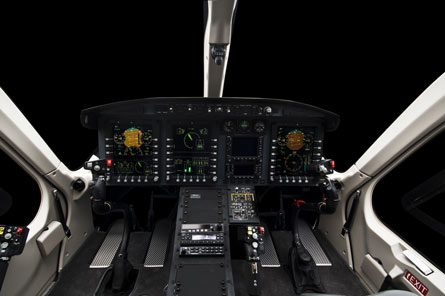When Bell decided to produce an eight-seat, single-pilot IFR twin-engined helicopter, there was a choice of updating its 427 model or starting with a blank sheet.
It chose the latter, using its modular affordable product line system (MAPL). This is a technology think-tank that studies how to produce an aircraft that the customers want, is cost effective and is manufactured easily with modules.
The result was the 429. Instead of Bell's usual method of taking a visual flight rules ship and adding an instrument flight rules kit, the airframer chose to produce a fully single-pilot IFR machine from the outset. This was one of the many customer requirements/inputs.
Others included :
- A flexible cabin arrangement where seats can be removed or installed easily and quickly.
- The ability to remove the rear cabin bulkhead leading into the baggage bay to provide a large flat floor with many tie-down points. Bell says that removing all the seats takes 2-3min and the bulkhead about 30min. This allows the cabin volume to go from 5.8m3 (204ft3) to 6.6m3.
- The ability to add any of the many optional extras without significant loss of payload. The payload is already very high for an aircraft of this size - 1,168kg (2,570lb).
- Fully adjustable crew seats with arm rests to suit a large range of pilot sizes.
- Space in the cockpit for extra equipment. Also a flat bottom to the tail boom for installing customer antennas.
- There were also pilot inputs. As is not unusual, the head of the cyclic stick can be large, full of switches and knobs. The pilots requested and got a much simpler arrangement. I, as a newcomer to the aircraft without the aid of a conversion course, was able to find my way around the various switches and knobs without a problem.
- Other significant features are the wide sliding doors giving just over 157cm (62in) access on both sides. Although the aircraft can be fitted with rear clam doors, ideal for stretcher loading, stretchers can be easily loaded through the side doors too.
There is such attention to detail that the aircraft can be configured for corporate use (VIP interior) emergency medical services (two litters with two to three medical attendants), law enforcement with swivel seats, utility or offshore. The offshore arrangement has the flotation gear and life rafts on one bar of the skids with a quick release control connection. The customer can order one, two or no rafts.
 |
|---|
© Bell HelicopterPilot requests contributed to the Bell 429 design |
There are five-passenger seating arrangements from four large plush seats with cocktail cabinet to two rows of three each. The front row can be forward or rearward facing. The 429 is the only helicopter in its size to offer two rows of forward facing seats. Seat widths are 39cm, 47cm and 55cm. They are sited on rails and can be individually removed and replaced.
All seats have shoulder harnesses, the passengers three-point, the pilots four. All are crash attenuating. Each seat has its own light, air conditioning vent and intercom plug-in receptacle. The lights can also be controlled by the pilot. There is plenty of leg and head room.
Because of the wide range of possible tasks, Bell has given the 429 a wide range of centre of gravity, both fore and aft and lateral. This allows a 272kg hoist to operate outboard of the skid gear. No ballast is required for the majority of missions.
The two front crew seats are ergonomically designed, fully adjustable with adjustable lumbar support. This makes a pleasant change from some of the "planks" that your test pilot has sat on in some older cockpits. There is ample head room for a tall pilot wearing night vision goggles or helmet. The goggles are optional.
Source: Flight International



















